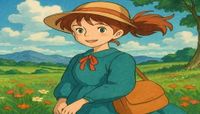OpenAI has made a significant leap in democratizing creativity by rolling out its image generation feature for free users of ChatGPT. This major update, launched in early April 2025, allows anyone with internet access to create stunning visuals simply by providing text descriptions. Previously, this feature was exclusive to paid subscribers, but now it opens up a world of possibilities for hobbyists, educators, marketers, and anyone interested in visual storytelling.
The image generation tool, powered by the advanced DALL·E model, enables users to produce original images that can range from whimsical illustrations to detailed product mockups. According to OpenAI, the model is trained on a vast dataset of images and text, allowing it to generate relevant and coherent visuals based on user prompts. This capability has already led to a surge in creative content, particularly with users generating Studio Ghibli-style artwork, which has become a viral trend since the update.
However, as the popularity of AI-generated images grows, so do concerns regarding authenticity and the distinction between human-created and AI-generated content. In response, OpenAI is reportedly testing a watermark for images produced by free-tier users. AI researcher Tibor Blaho discovered references to this watermark in the code of ChatGPT’s image generation model. The watermark is designed to subtly indicate that an image was created using AI, although it is still in the testing phase and has not been officially confirmed by OpenAI.
This watermarking initiative appears to be a strategic move by OpenAI to address the ongoing debates surrounding copyright and the integrity of user-generated content. As more individuals share AI-generated art online, the need for clear labeling becomes critical—not just for artists and developers, but also for the general public. The watermark is expected to help users identify AI-generated images without compromising the visual appeal of the artwork.
Interestingly, the watermark is currently limited to images generated using the free version of ChatGPT. This decision has raised eyebrows, as it may serve as an incentive for users to upgrade to premium subscriptions, where they can save images without the watermark. While the exact details regarding the watermark's implementation remain unclear, it reflects a broader trend in the AI industry where companies are increasingly adopting watermarking practices to distinguish AI-generated content.
OpenAI's decision to make the image generation tool free is a bold step towards making creative technology accessible to a wider audience. This change has the potential to empower individuals ranging from students to entrepreneurs, allowing them to explore a variety of applications—from creating educational materials to developing marketing visuals.
The tool’s versatility is noteworthy, enabling users to create content for blogs, social media, educational graphics, product visualizations, and even event marketing materials. For instance, a teacher could generate a custom illustration to explain a complex scientific concept, while a marketer could create eye-catching visuals for a campaign.
Despite its many advantages, users should be aware of the tool's limitations. OpenAI has implemented strict guidelines to prevent the generation of inappropriate content, including NSFW or violent themes. Users cannot create realistic images of real individuals in misleading contexts, and the model is programmed to reject prompts that violate these policies. Additionally, while the AI can produce lifelike images, there are some restrictions in terms of photorealism, particularly with human subjects.
As the image generation feature continues to evolve, OpenAI is also developing an API for the tool. This API aims to facilitate third-party developers in creating their applications around the image generation model, further expanding its reach and usability. However, it remains to be seen whether the watermark will extend to images generated via the API or be exclusive to ChatGPT users.
OpenAI's move to provide free access to its image generation capabilities is a clear indication of the company's commitment to fostering creativity and innovation. By removing financial barriers, they are encouraging users to engage with AI technology in meaningful ways. The implications of this shift are far-reaching, potentially transforming how individuals and businesses approach content creation.
In summary, the introduction of free image generation through ChatGPT marks a pivotal moment in the intersection of technology and creativity. As users embrace this powerful tool, the conversation around AI-generated content and its implications will undoubtedly continue to evolve. With the upcoming watermarking feature, OpenAI is taking proactive steps to ensure that users can navigate this new landscape responsibly and ethically.




